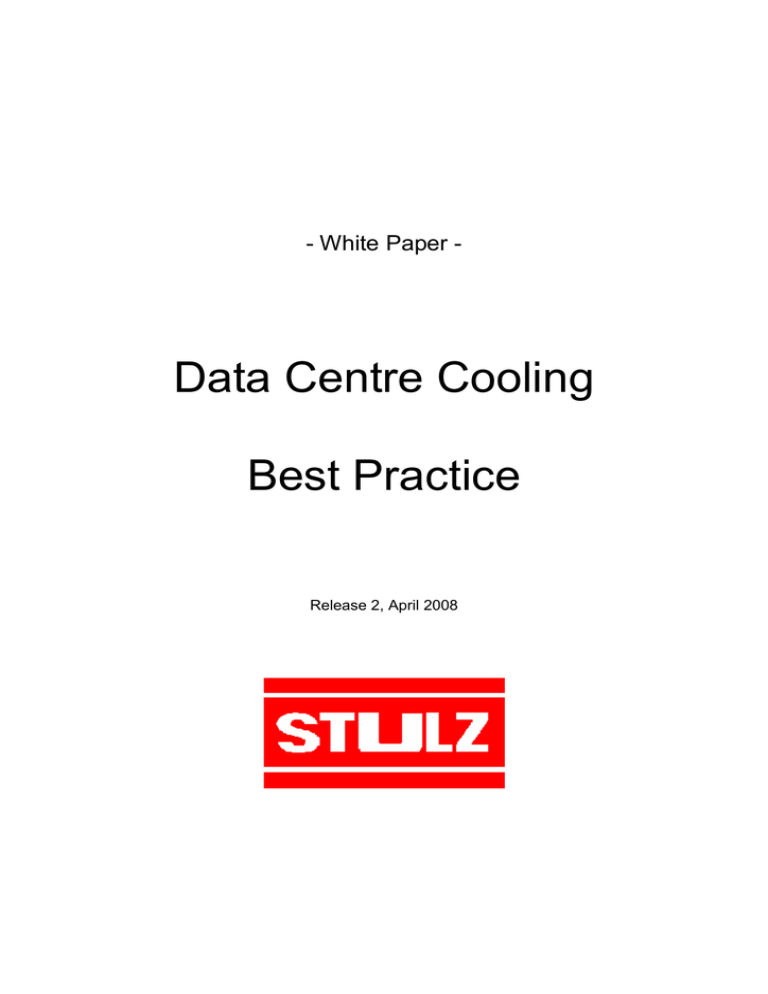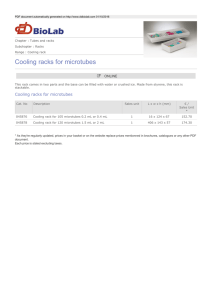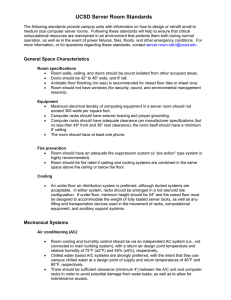
- White Paper -
Data Centre Cooling
Best Practice
Release 2, April 2008
Contents
INTRODUCTION ..................................................................................................................................... 3
1.
AIR FLOW LEAKAGE ................................................................................................................... 3
2.
PERFORATED TILES: NUMBER AND OPENING FACTOR ....................................................... 4
3.
PERFORATED TILES: WITH ADJUSTABLE DAMPER .............................................................. 4
4.
PERFORATED TILES: PLACEMENT ........................................................................................... 4
5.
CLOSE UNUSED UNITS IN THE RACKS WITH BLANKING PANELS TO AVOID AIRFLOW
SHORT CIRCUIT INSIDE THE RACK........................................................................................... 5
6.
AIRFLOW PHILOSOPHIES ........................................................................................................... 5
7.
RAISED FLOOR HEIGHT .............................................................................................................. 7
8.
RETURN AIR CONDITIONS .......................................................................................................... 7
9.
CHILLED WATER SYSTEM WATER CONDITIONS .................................................................... 8
10.
STANDBY UNIT OPERATION....................................................................................................... 9
11.
USE CRAC UNITS WITH STATE OF THE ART COMPRESSOR AND FAN TECHNOLOGY .... 9
12.
USE OF RAISED-FLOOR-PRESSURE CONTROLLED AIRFLOW........................................... 10
©2008 Stulz - All rights reserved
Data Center Cooling – Best Practice
Page 2 of 10
Introduction
This paper summarises today’s best practise for data center cooling systems. The
raised floor design, cold and hot air separation, perforated tile issues and design air
and water conditions are described. Target of these best practise collection is to
design and build data center cooling systems as efficient as possible.
1. Air Flow Leakage
Air Flow Leakage leads to dramatic inefficiencies due to air circulation back to CRAC
units without taking sufficient amount of heat from the equipment (short air circuit). A
huge amount of fan power is wasted to circulate the air in such unwanted way.
Measures:
•
Close all unwanted openings on the floor
•
Close all unwanted openings below the racks, some raised floors all fully open
underneath the racks even if perforated tiles are used for the regular airflow
through the room.
•
Close all cable cut outs where e.g. 10% of the openings are used for cables
and 90% are simply open and air leaks to the room.
•
Close all unwanted openings near walls where just some cut tiles would be
necessary to seal the gap.
Target is to create a certain overpressure of e.g. 20 Pa to realise an even air supply
to the data center at all areas. This is only possible if the raised floor is able to create
such overpressure due to a proper design with as low as possible amount of
unwanted airflow leakage. If this overpressure is realised, all perforated tiles will
supply an even airflow.
©2008 Stulz - All rights reserved
Data Center Cooling – Best Practice
Page 3 of 10
2. Perforated Tiles: Number and Opening Factor
The number of perforated tiles must be in line with a) the design and b) actual/real
total airflow. The perforated tiles have their specific characteristic, this means at a
certain design pressure difference e.g. 20Pa the required air volume is supplied. If
the CRAC units are designed for e.g. 50,000m³/h at an external static pressure of
20Pa, the number and design air volume of the perforated tiles must be equal to the
total design air volume. E.g. 500m³/h @ 20Pa tiles will be installed, so 100 pieces are
required. If the real airflow (required due to any reason) is lower, e.g. 30,000m³/h, the
20Pa external static pressure still must be achieved to ensure equal air supply
anywhere in the room, the number of perforated tiles must be reduced to 60 instead
of 100. If 100 perforated tiles will remain at reduced airflow, it will lead to a reduced
static pressure in the raised floor (according to the perforated tile characteristic) of
e.g. 5Pa. This low static pressure leads to an uneven air distribution and eventually
lack of cooling in some areas.
3. Perforated Tiles: With adjustable damper
Perforated tiles with integral adjustable dampers can be used to avoid having to
replace perforated tiles with solid tiles. In this case the number of perforated tiles can
remain unchanged, but all of them need to be adjusted. It’s also possible to operate
with different adjustments to vary the amount of air in different areas. It is important
to keep the static pressure in the raised floor at the design level.
4. Perforated Tiles: Placement
Perforated tiles should be placed only at positions, where cold air is really required to
cool equipment. Do not place perforated tiles near CRAC units; keep at least 2m
distance. Perforated tiles near CRAC units can induce warm room air into the raised
floor (negative airflow) instead providing cold supply air from the raised floor into the
room. This happens due to high air velocity and corresponding high velocity pressure
in these areas in the raised floor near the CRAC units.
©2008 Stulz - All rights reserved
Data Center Cooling – Best Practice
Page 4 of 10
5. Close unused units in the racks with blanking panels to avoid airflow short
circuit inside the rack
Recirculation of cooling air inside the rack leads to overheating of servers. Air will
always take the path of least resistance and blanking plates are required to fill gaps
in racks where servers have been removed or not installed, otherwise hot exhaust air
from the server will circulate through the “gap” back to the air intake of the server.
Measures:
•
Use blanking panels to close any unused server slot in racks.
6. Airflow philosophies
•
The old/traditional way
Uncontrolled placement of perforated supply air tiles anywhere in the room in
any aisle. Cold air is supplied in an uncontrolled way to the low density
equipment. Uncontrolled recirculation and supply and return air mixing
happens. Hot exhaust air of one blade center can enter the equipment of a
rack in the next row which leads to equipment overheating. NOT
RECOMMEND NOWADAYS. Very inefficient.
•
Hot Aisle, Cold Aisle Concept
Racks will be positioned in rows front to front and back to back. Cold aisles
only will be equipped with perforated tiles. No perforated tiles in the hot aisle.
This concept helps to reach a certain level of separation between cold supply
air and hot return air. There is still the risk of mixing between supply and
return air through the top of the racks and at the end of the rows.
©2008 Stulz - All rights reserved
Data Center Cooling – Best Practice
Page 5 of 10
•
Hot Aisle Containment
Racks will be positioned in rows back to back. The hot aisle in between racks
will be covered on the top and at the end of the rows and ducted back to the
CRAC unit. A full separation between supply and return air is achieved. Cold
supply air will be delivered into the room and the room itself will be at a low
temperature level.
•
Cold Aisle Containment
Racks will be positioned in rows front to front. The cold aisle in between
racks will be covered on the top and at the end of the rows. A full separation
between supply and return air is achieved. Cold air will be supplied through
the raised floor into the contained cold aisle; hot return air leaves the racks
into room and back to the CRAC unit. The room itself will be at a high
temperature level.
•
Direct In-Rack Supply, Room Return Concept
Cold supply air from the CRAC enters the rack through the raised floor
directly in the bottom front area. Hot return air leaves the rack directly into the
room. A full separation between supply and return air is achieved. The room
itself will be at a high temperature level.
•
Room Supply, Direct Rack-Out Return Concept
Cold supply air from the CRAC enters the rack through the room. Hot return
air leaves the rack through a duct and suspended ceiling directly back to the
CRAC unit. A full separation between supply and return air is achieved. The
room itself will be at a low temperature level.
•
Close coupling of CRAC units and Racks on Supply and Return Side
Cold supply air from the CRAC enters the rack through the raised floor
directly in the bottom front area. Hot return air leaves the rack through a duct
and suspended ceiling directly back to the CRAC unit.
©2008 Stulz - All rights reserved
Data Center Cooling – Best Practice
Page 6 of 10
A full separation between supply and return air is achieved. The room itself
will be at an average temperature level.
•
Aisle Separation Concept
Base on the hot aisle, cold aisle concept the separation between supply and
return will be realised as complete as possible, e.g. by installation of panels
between top of the rack and ceiling to reduce supply and return air mixing to
the minimum.
Airflow philosophies summary
Target of these various philosophies are the separation of cold supply air from the
CRAC unit and hot return air back to the CRAC unit. This leads to an increased
temperature difference between supply and return air thus increasing the efficiency of
the CRAC unit and therefore the efficiency of the data center in general. If each m² of
circulating air takes the design amount of heat from the IT equipment, the highest
level of efficiency is reached.
7. Raised Floor Height
The raised floor height has a major influence on the efficiency of the air circulation in
a CRAC unit based cooling system. Usually the raised floor contains cabling, piping
and cold air. A certain obstruction free area is required for a proper supply of cold air
to any area of the room. The required free height depends on the room size, the heat
density and the number and position of installed CRAC units, finally on the total
amount of air which has to circulate through the raised floor. General rule of thumb:
The higher the better. A 1,000m² room with an heat density of 1kW/m² needs approx.
300.000m³/h air and a free raised floor height of at least 500mm.
8. Return Air Conditions
Traditional CRAC based cooling systems are designed and will be operated at return
air (the warm air coming back from the room to the CRAC unit) of 22°C to 24°C
sometimes even lower.
©2008 Stulz - All rights reserved
Data Center Cooling – Best Practice
Page 7 of 10
By doing so the cold supply air delivered from the CRAC through the raised floor to
the room has a temperature of approx. 14°C to 16°C. In the past when totally
uncontrolled airflow and a huge amount of mixing and bypassing took place it was
necessary to have low room temperatures to compensate. Nowadays, where the
airflow through the data centre is more and more defined and mixing, leaking,
bypassing, recirculation of air is reduced to a minimum, the cooling system can
operate at much higher temperatures. The server equipment to be cooled operates
easily at inlet temperatures of 20°C and above and the supply temperature level can
be increased 5°C to 6°C and return air temperatures of around 30°C will become
common practice.
At such conditions CRAC units operate much more efficiently and free cooling
systems can run many more hours per year in free cooling mode. These higher
return air temperatures can easily achieved with chilled water CRAC units.
Compressor based CRAC units can also operate at these higher return air
temperatures, but typically at reduced air volumes to ensure proper conditions in the
refrigeration circuit.
9. Chilled Water System Water Conditions
The entering water temperature (EWT) and leaving water temperature (LWT) of
chilled water systems (chilled water CRAC units in the data centre and chiller with or
without free cooling outside) have a major influence on the efficiency and energy
consumption.
Heat loads in Data Centres are nearly all sensible cooling load with only a small
latent cooling load associated with fresh air ventilation. Therefore, the chilled water
temperature leaving the chiller can be elevated from a normal 6° or 7° for air
conditioning applications to 10°C or even higher. It should be considered as not only
the CRAC unit provide all sensible cooling but the efficiency of the chiller will
increase.
The higher the chilled water temperature the longer the freecooling season will be
available for systems designed to utilise low ambient freecooling. Chilled water
freecooling is a technique where drycoolers or chillers with an integral drycooling coil
are piped in series with the chillers evaporator to pre-cool the chilled water when the
©2008 Stulz - All rights reserved
Data Center Cooling – Best Practice
Page 8 of 10
outside ambient temperature is low. A glycol solution is introduced into the chilled
water to prevent the drycooler coil from freezing and controls bypass the drycooler to
prevent the drycooler from pre-heating the glycol / chilled water when the outside
ambient temperature is high and no longer a freecooling source.
Designers need to balance the chiller efficiency and freecooling benefits with the
drop off in cooling capacity of the CRAC unit when supplied with elevated chilled
water temperatures and the introduction of glycol.
10. Standby Unit Operation
Fan laws dictate that air volume is directly proportional to fan speed and that fan
power is a cube of the fan speed. Therefore, by running the stand-by CRAC units at
reduced speed (air volume) the overall fan power is greatly reduced. The use of high
efficiency EC fans allows automatic control of fan speed as dictated by standby
operation, room cooling load or underfloor static pressure. It is more energy efficient
to run all units including the standby CRAC units at lower speed than shut off or
sequence off the standby unit(s). This technique also provides a more even and
predictable air distribution.
11. Use CRAC units with state of the art Compressor and Fan Technology
State of the art compressor technology is scroll technology which operates more
energy efficient then piston compressors. Today’s state of the art fan technology is
the plug type fan with EC motor which is also much more efficient then centrifugal
fans with external motor and belt or plug fans with AC motor. Anything else than EC
fans is not recommended to be used anymore in modern CRAC units. The use of
speed controlled compressors (digital or with frequency converter) is discussed
frequently; however, it is advisable only for small rooms with variable loads larger
than 40% as in large installations the on-off control of a number of compressors is
more energy efficient.
©2008 Stulz - All rights reserved
Data Center Cooling – Best Practice
Page 9 of 10
12. Use of raised-floor-pressure controlled airflow
The raised floor pressure (also called ESP, external static pressure) is a key
parameter for energy efficient air movement through the data centre. By doing so,
only the really required amount of air will be moved through the data centre which
saves fan absorbed power in the CRAC units. Traditional data centres are designed
for an ESP of approx. 20Pa for an even air supply at any area of the room. Reality is
different; values vary typically less than 10Pa with corresponding uneven air
distribution. Latest designs operate with raised-floor-pressure controlled airflow.
Depending on the difference of the measured pressure and its desired value the
airflow will be varied to keep the pressure constant.
This is possible with the latest EC fan technology. Pressure variations happen
especially in systems, where the cold air will be delivered through the raised floor
directly into the racks. The rack mounted servers vary the speed of their internal fans
due their load status. This variation leads to pressure variations in the rack in front of
the server and this area is directly connected to the raised floor. This control system
adapts automatically the required total airflow to the demand of the servers in the
racks. Other applications with perforated tiles with adjustable dampers for raisedfloor-pressure controlled airflow can be achieved by varying the opening degree of
the dampers. The actual raised floor pressure will be altered and the airflow will be
adapted accordingly to keep the pressure constant to ensure even air supply at any
area in the room.
About the Author:
Benjamin Petschke is Head of Product Management and Sales Support. After studying physics
Benjamin joined Stulz in 1996 as R&D engineer. In 1997 he changed to the sales department and
worked in different positions. Benjamin Petschke is specialised in data center design regarding air
conditioning, energy saving and acoustic issues.
About Stulz GmbH:
Founded in 1947 in Germany, Stulz has specialized in areas requiring technological expertise and
entrepreneurial flexibility. The family owned company looks back at more than 30 years of experience
in the design & built of data centres in terms of air conditioning. Being a true global player Stulz is
present today in over 100 countries worldwide with production sites in Germany, USA, Italy, China and
India.
©2008 Stulz - All rights reserved
Data Center Cooling – Best Practice
Page 10 of 10




